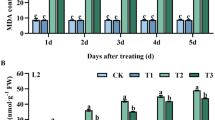Abstract
Previous studies have shown that uniconazole inhibits ethylene synthesis and protects plants from various stresses. The present research was conducted to delineate the mechanism of ethylene inhibition by uniconazole [(E)-(p-chlorophenyl)-4,4-dimethyl-2-(1,2,4-triazol-1-yl)-1-penten-3-ol]. Following heat stress of 48°C for 3 h, the shoots of the control wheat seedlings became desiccated, and the seedlings lost 23% of their fresh mass 8 h after stress. The control soybean seedlings had epinastic unifoliate leaves 5 h after foliar application (4.4 g.a.i./ha) of the herbicide triclopyr [(3,5,6-trichloro-2-pyridinyl)oxyacetic acid]. Soil drench applications of uniconazole, a potent member of the triazole family, reduced these symptoms associated with heat and herbicide stress in wheat (5.0 mg/L) and soybean (0.4 mg/L) seedlings, respectively.
Basal ethylene production was inhibited 32 and 48% by uniconazole in the wheat and acotyledonous soybean seedlings, respectively. Following a 48°C heat stress, 1-aminocyclopropane-1-carboxylic acid (ACC) levels increased 40% in both the control and uniconazole-treated wheat seedlings. After triclopyr application, ACC levels increased 400% in both the control and uniconazoletreated soybean seedlings. The increased ACC levels, following stress, were accompanied by increased ethylene production from the control, but not from the uniconazole-treated wheat and acotyledonous soybean seedlings. Uniconazole treatment did not significantly change the basal or stress-induced N-malonyl-1-aminocyclopropane-1-carboxylic acid (MACC) levels compared to controls. These results suggest that uniconazole inhibits ethylene synthesis by interfering with the conversion of ACC to ethylene in wheat and acotyledonous soybean seedlings. Ethylene production and ACC conversion were not inhibited by uniconazole in excised soybean cotyledons. These results indicate that different ethylene-forming enzyme (EFE) systems operate in the soybean acotyledonous seedling and cotyledon, and the system in the former is inhibited by uniconazole.
Similar content being viewed by others
References
Abbas S, Fletcher RA, Murr DP (1989) Alteration of ethylene synthesis in cucumber seedlings by triademefon. Can J Bot 67:278–280
Adams DO, Yang SF (1979) Ethylene biosynthesis: Identification of 1-aminocyclopropane-1-carboxylic acid as an intermediate in the conversion of methionine to ethylene. Proc Natl Acad Sci USA 76:170–174
Apelbaum A, Yang SF (1981) Biosynthesis of stress-ethylene induced by water deficit. Plant Physiol 68:594–596
Asare-Boamah NK, Hofstra G, Fletcher RA, Dumbroff EB (1986) Triademefon protects bean plants from water stress through its effects on abscisic acid. Plant Cell Physiol 27:383–390
Axelrod B, Cheesbrough TM, Zimmer S (1981) Lipoxygenase from soybeans. Meth Enzymol 71:441–451
Booker HM, Gillespie TJ, Hofstra G, Fletcher RA (1991) Uniconazole-induced thermal tolerance in wheat seedlings is mediated by transpirational cooling. Physiol Plant (in press)
Bousquet J-F, Thimann KV (1984) Lipid peroxidation forms ethylene from 1-aminocyclopropane-1-carboxylic acid and may operate in leaf senescence. Proc Natl Acad Sci USA 81:1724–1727
Crocker W, Zimmerman PW, Hitchcock AE (1932) Ethylene-induced epinasty of leaves and the relation of gravity to it. Contrib Boyce Thompsom Instit 4:177
Davis TD, Steffens GL, Sankhla N (1988) Triazole plant growth regulators. Hortic Rev 10:63–105
Fletcher RA, Hofstra G (1985) Triademefon a plant multiproctectant. Plant Cell Physiol 26:775–778
Fletcher RA, Hofstra G (1988) Triazoles as potential plant protectans. In: Berg D, Plempel M (eds) Sterol biosynthesis inhibitors: Pharmaceutical and Agricultural aspects. Ellis Horwood Ltd., England, pp 321–331
Fletcher RA, Santakumari M, Murr DP (1988) Imposition of water stress in wheat improves the efficacy of uniconazole-induced thermal resistance. Physiol Plant 74:360–364
Grossmann K, Hauser C, Sauerbrey E, Fritsch H, Schmidt O, Jung J (1989) Plant growth retardants as inhibitors of ethylene production. J Plant Physiol 134:538–543
Hoffman NE, Yang SF, McKeon T (1982) Identification of 1-(malonylamino)cyclopropane-1-carboxylic acid as a major conjugate of 1-aminocyclopropane-1-carboxylic acid, an ethylene precursor in higher plants. Biochem Biophys Res Commun 104:765–770
Hofstra G, Krieg LC, Fletcher RA (1989) Uniconazole reduces ethylene and 1-aminocyclopropane-1-carboxylic acid and increases spermine levels in mung bean seedlings. J Plant Growth Regul 8:45–51
Kacperska A, Kubacka-Zebalska M (1989) Formation of stress ethylene depends both on ACC synthesis and on the activity of free radical-generating system. Physiol Plant 77:231–237
Lizada MCC, Yang SF (1979) A simple and sensitive assay for 1-aminocyclopropane-1-carboxylic acid. Anal Biochem 100:140–145
Lynch DV, Sridhara S, Thompson JE (1985) Lipoxygenasegenerated hydroperoxides account for the nonphysiological features of ethylene formation from 1-aminocyclopropane-1-carboxylic acid by microsomal membranes of carnations. Planta 164:121–125
Mathuessen AM (1989) Ethylene, ACC and MACC in the seeds and young seedlings ofPhaseolus vulgaris L. Diss Abs Intl, Biol Sci Eng 49:12
Rademacher W, Fritsch H, Graebe JE, Sauter H, Jung J (1987) Tetcyclasis and triazole-type plant growth retardants: Their influence on the biosynthesis of gibberellins and other metabolic processes. Pestic Sci 21:241–252
Sauerbrey E, Grossmann K, Jung J (1988) Ethylene production by sunflower cell suspensions: Effects of plant growth retardants. Plant Physiol 87:510–513
Wang T-T, Yang SF (1987) The physiological role of lipoxygenase in ethylene formation from 1-aminocyclopropane-1-carboxylic acid in oat leaves. Planta 170:190–196
Wright STC (1977) The relationship between leaf water potential and the levels of abscisic acid and ethylene in excised wheat leaves. Planta 134:183–189
Yang SF, Hoffman NE (1984) Ethylene biosynthesis and its regulation in higher plants. Annu Rev Plant Physiol 35:155–189
Yang SF, Liu Y, Su L, Peiser GD, Hoffman NE, McKeon T (1985) Metabolism of 1-aminocyclopropane-1-carboxylic acid. In: Roberts JA, Tucker GA (eds) Ethylene and plant development: Butterworths, London, pp 9–22
Author information
Authors and Affiliations
Rights and permissions
About this article
Cite this article
Kraus, T.E., Murr, D.P. & Fletcher, R.A. Uniconazole inhibits stress-induced ethylene in wheat and soybean seedlings. J Plant Growth Regul 10, 229–234 (1991). https://doi.org/10.1007/BF02279340
Received:
Accepted:
Issue Date:
DOI: https://doi.org/10.1007/BF02279340




